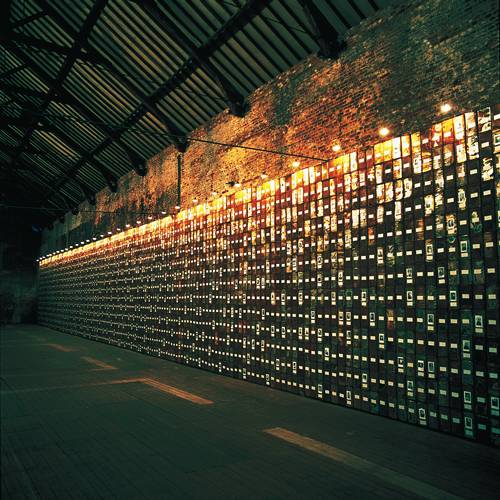 I went to see Christian Boltanski's commerative piece to all the Crossley factory workers, from its opening in 1877, to its closure in 1982, in the Dean Clough Exhibition, in Halifax. I loved the archival quality of the work and the choice of lighting in the enclosed, cellar space. It was as if I had taken a misturn, as the area looked like it had been neglected by the gallery; which added a new dimension to the contrived space.
I went to see Christian Boltanski's commerative piece to all the Crossley factory workers, from its opening in 1877, to its closure in 1982, in the Dean Clough Exhibition, in Halifax. I loved the archival quality of the work and the choice of lighting in the enclosed, cellar space. It was as if I had taken a misturn, as the area looked like it had been neglected by the gallery; which added a new dimension to the contrived space. Boltanski carries on the artistic practice of the 1960s and 70s, by bringing found, commonplace objects into museum or gallery settings. Ordinary materials such as metal biscuit tins, discarded clothes, domestic lamps and snapshop photographs recur regularly in his installations, and did so in his The Work People of Halifax 1877. This work seemed to represent the ordinarity of the worker's lives, as Boltanski had used articles from various sources and had randomly intermingled them, so to portray the overall histories of the workers. The objects in the drawers were also highly ubique, though carried a high cultural and social importance, which created a seemingly collective memory of the Crossley workers. By presenting rephotographed photos or multiple images of the same photograph, the artist avoided presenting any distinctive aspect or personality of the workers, instead an archtypal image of a worker was formed.
The inclusion of clothes, as elements for classification and documentation, also made the work quite potent, as clothes seemed to suggest the body's presence and its passing. In this work, the clothes seemed to be a surrogate for the workers, which added an intimacy between the viewer and the carpet factory workers.
I also really liked the incorporation of objects which had a patina of age; as the images looked aged and some lightly bent or ripped, whilst the metal objects showed hints of rust. The deterioration of the objects allowed them to appear like a momento mori, as the materials were a literal embodiment of the passing of time. The archival placement of the objects also created a sense of loss, as the things were obviously disconnected from their usual environments. Furthermore, the inclusion of simple and familiar objects seemed to allow the Dean Clough visitor to bring their own history and memories to the work, which I found particularly effective.
'My work must act as a stimulus which makes it possible to rediscover a previous forgotten emotion'.

Christian Boltanski, Les Registres du Grand-Hornu, 1997, Paris.
No comments:
Post a Comment